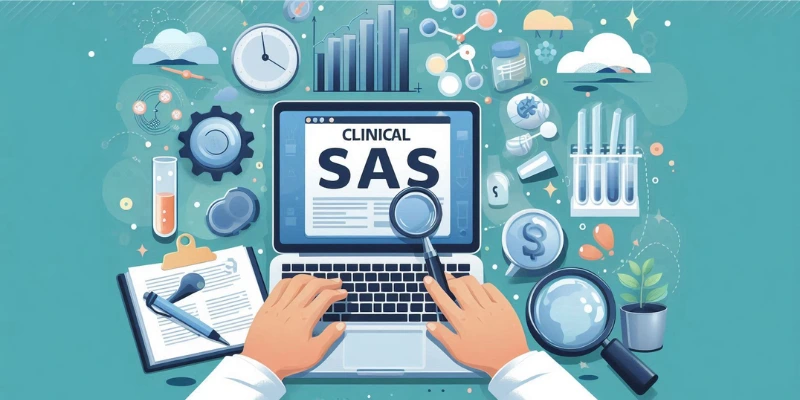
Clinical SAS is a software application used in the domains of clinical research and the pharmaceutical industry. It is primarily used for analyzing data collected from clinical trials. This is used to achieve a result that meets regulatory standards and provides data ready for submission to authorities, such as the FDA. The primary role of the clinical SAS programmer is to transform raw data into actionable insights, utilizing tables, listings, and figures to inform the evaluation of new drug safety and efficacy.
In the digital world, the demand for clinical trials and drug development using data has increased rapidly. As the pharmaceutical industry expands, there is a growing need for professionals to manage and analyze clinical data effectively. It presents a promising path, offering a unique blend of healthcare, statistics, and technology. It is the perfect time to enter a high-demand industry that offers global opportunities through expert Clinical SAS Training in Chennai, provided by the FITA Academy.
What is Clinical SAS Programming?
Clinical SAS programming is a software that is used to manage, analyze, and report data collected during clinical trials. This software is a powerful tool used as a statistical tool in the pharmaceutical and healthcare industries due to its features, such as handling large data files with precision and accuracy of the results for the given trial data. Given that the trial data, generated from clinical data, is massive.
Programmers must process the data in accordance with strict regulations and guidelines. When involved in these processes, they create data tables and charts through programming while cleaning, organizing, and analyzing the data in a clear and structured manner. These programmers work closely with departments such as clinical research, statistics, and regulatory teams to ensure the accuracy of trial data. They use specific tools designed for Clinical SAS to carry out these tasks efficiently.
- Base SAS
- SAS/STAT
- SAS/GRAPH
- CDISC standards—specifically SDTM (Study Data Tabulation Model)
- ADaM (Analysis Data Model)
Clinical SAS programmers use these tools due to regulatory standards submission bodies, such as the FDA. Students and working professionals can learn about this course and its tools for data analysis within a specific timeframe with accuracy. Can enroll in the Training Institute in Chennai.
Growing Demand in the Pharmaceutical
In today’s developing countries, primary industries are rapidly growing to meet the increasing demand for keeping the population healthy and active, which in turn drives the nation’s economic growth. As chronic health concerns rise, pharmaceutical companies develop more drugs each day, leading to a surge in clinical trials. This increase creates a strong need for experts to manage clinical trial data in compliance with FDA and EMA regulations. Companies now submit this data in a standardized format, which requires SAS programming. This creates a strong demand for SAS programmers to support the drug approval process through the Clinical SAS role.
Using Clinical SAS helps you reduce operational costs. Many pharmaceutical companies now outsource clinical data to operations companies based in India. Expert programmers, who typically hold graduate degrees in science or technology, lead this growing field. India has now emerged as a hub for these professionals, creating wide-open job opportunities for aspiring clinical programmers—especially recent graduates.
Career Opportunities
If you’re a student interested in building a career in Clinical SAS, consider the following opportunities. There are excellent opportunities for growth in the pharmaceutical and healthcare industries. The entry-level roles by learning clinical SAS are:
- Clinical SAS Programmer
- Statistical Programmer
- Data Analyst
These professionals process and analyze clinical data to ensure accuracy and meet global regulatory standards. As they gain experience, they can advance to senior roles such as Senior SAS Programmer, Team Lead, or Project Manager. Pharmaceutical companies, biotech firms, and Contract Research Organizations (CROs) actively hire clinical SAS professionals as clinical research continues to expand globally. We have explored the role of a clinical SAS programmer and recognized the growing demand for skilled SAS professionals.
Skills You should Gain to be a Clinical SAS programmer
By learning Clinical SAS, students can acquire essential skills—including both technical and analytical capabilities—that are crucial in the pharmaceutical and healthcare industries. Furthermore, by gaining hands-on experience through internships and working with real clinical trial datasets, they can apply their knowledge in a practical setting. Through this process, they not only learn how to clean, manage, and validate data, but also ensure compliance with regulations and standards, such as those set by the FDA. Moreover, those who utilize Clinical SAS to understand the charting and visual representation of clinical data will gain a competitive edge in the real world. Ultimately, mastering these skills prepares students to thrive in a data-driven healthcare environment.
Understanding how to generate charts, tables, and listings in clinical research highlights the importance of studying data collection. Communicate and collaborate with the clinical team to gain practical insights. By learning this through the course, which covers topics from basic to advanced, you will clearly understand what to learn and which tools to use in this role.
In this blog, we have explored the clinical SAS programming course, a rapidly growing field, and who can choose clinical SAS program? It has immense potential, particularly in the pharmaceutical and healthcare industries. As in this evolving generation, there is a global rise. Clinical trials are increasing, and the emphasis on data-driven drug development is growing. The industry consistently demands skilled Clinical SAS professionals. For students and recent graduates, this trend creates a unique opportunity to build a high-demand, high-paying career with strong growth prospects. Learning this course early helps you gain a competitive edge and secure a stable future in the life sciences domain.
